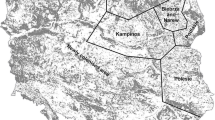Abstract
A new ground-based technique for estimating the density of nesting Adélie penguins (Pygoscelis adeliae) within occupied habitat is described and evaluated using an experimental approach with model penguins. In this set-up, an operator takes photos with a camera mounted on a 3-m pole at pre-determined sampling locations within habitat occupied by nesting penguins, and the actual boundaries of the plot in which penguin density is estimated are added post-survey. Density estimates are calculated by overlaying slope-specific templates delineating plot boundaries and distances of known dimensions onto the digital photos to allow a distance-sampling analysis to correct for any negative bias in counts arising from a proportion of penguins being obscured. Experimental assessment of biases in density estimates because of misclassification error was <2% when compared to true density, indicating that this survey method is effective at accurately estimating penguin density and, therefore, abundance.



Similar content being viewed by others
References
Ainley DG (2002) The Adélie penguin: bellwether of climate change. Columbia University Press, New York
Anderson DR, Burnham KP, Lubow BC, Thomas L, Corn PS, Medica PA, Marlow RW (2001) Field trials of line transect methods applied to estimation of desert tortoise abundance. J Wildl Manage 65:583–597
Barbraud C, Delord KC, Micol T, Jouventin P (1999) First census of breeding seabirds between Cap Bievenue (Terre Adelie) and Moyes Islands (King George V Land), Antarctica: new records for Antarctic seabird populations. Polar Biol 21:146–150
Buckland ST, Anderson DR, Burnham KP, Laake JL, Borchers DL, Thomas L (2001) Introduction to distance sampling: estimating abundance of biological populations. Oxford University Press, Oxford
Capurro A, Frere E, Gandini M, Gandini P, Holik T, Lichtschein V, Dee Boersma P (1988) Nest density and population size of Magellanic penguins (Spheniscus magellanicus) at Cabo Dos Bahias, Argentina. Auk 105:585–588
CCAMLR (2003) CCAMLR ecosystem monitoring program: standard methods for monitoring studies. CCAMLR, Hobart
Chamaillé-Jammes S, Guinet C, Nicoleau F, Argentier M (2000) A method to assess population changes in king penguins: the use of a geographical information system to estimate area–population relationships. Polar Biol 23:545–549
Jabłoński B (1980) Distribution and numbers of birds and pinnipedes on Penguin Island (South Shetland Islands) in January 1979. Polish Polar Res 1:109–116
Kerry KR, Clarke JR, Else GD (1995) The foraging range of Adélie penguins at Béchervaise Island, Mac.Robertson Land, Antarctica as determined by satellite telemetry. In: Dann P, Norman I, Reilly P (eds) The penguins. Surrey Beatty and Sons, Sydney, pp 216–243
Pollock KH, Marsh HD, Lawler IR, Alldredge MW (2006) Estimating animal abundance in heterogeneous environments: an application to aerial surveys for dugongs. J Wildl Manage 70:255–262
Taylor RH, Wilson PR, Thomas BW (1990) Status and trends of Adélie penguin populations in the Ross Sea region. Polar Rec 26:293–304
Thomas L, Laake JL, Strindberg S, Marques FFC, Buckland ST, Borchers DL, Anderson DR, Burnham KP, Hedley SL, Pollard JH, Bishop JRB, Marques TA (2006) Distance 5.0, Release 2. Research Unit for Wildlife Population Assessment, University of St Andrews, St Andrews. Available at www.ruwpa.st-and.ac.uk/distance/
Woehler EJ, Riddle MJ (1998) Spatial relationships of Adélie penguin colonies: implications for assessing population changes from remote imagery. Antarct Sci 10:449–454
Woehler EJ, Johnstone GW, Burton HR (1989) The distribution and abundance of Adelie penguins, Pygoscelis adeliae, in the Mawson area and at the Rookery Islands (specially protected area 2), 1981 and 1988. ANARE Research Notes 71. ANARE, Melbourne
Acknowledgements
We thank the 2005/06 summer crew at Mawson station for logistical support, Steve Whiteside and Peter De Vries for help in creating the penguin models, and two anonymous referees for their comments on an earlier draft of this paper.
Author information
Authors and Affiliations
Corresponding author
Rights and permissions
About this article
Cite this article
Low, M., Meyer, L. & Southwell, C. Experimental evaluation of a new ground-based survey method for estimating the density and abundance of nesting Adélie penguins Pygoscelis adeliae . Polar Biol 31, 309–315 (2008). https://doi.org/10.1007/s00300-007-0359-y
Received:
Revised:
Accepted:
Published:
Issue Date:
DOI: https://doi.org/10.1007/s00300-007-0359-y




